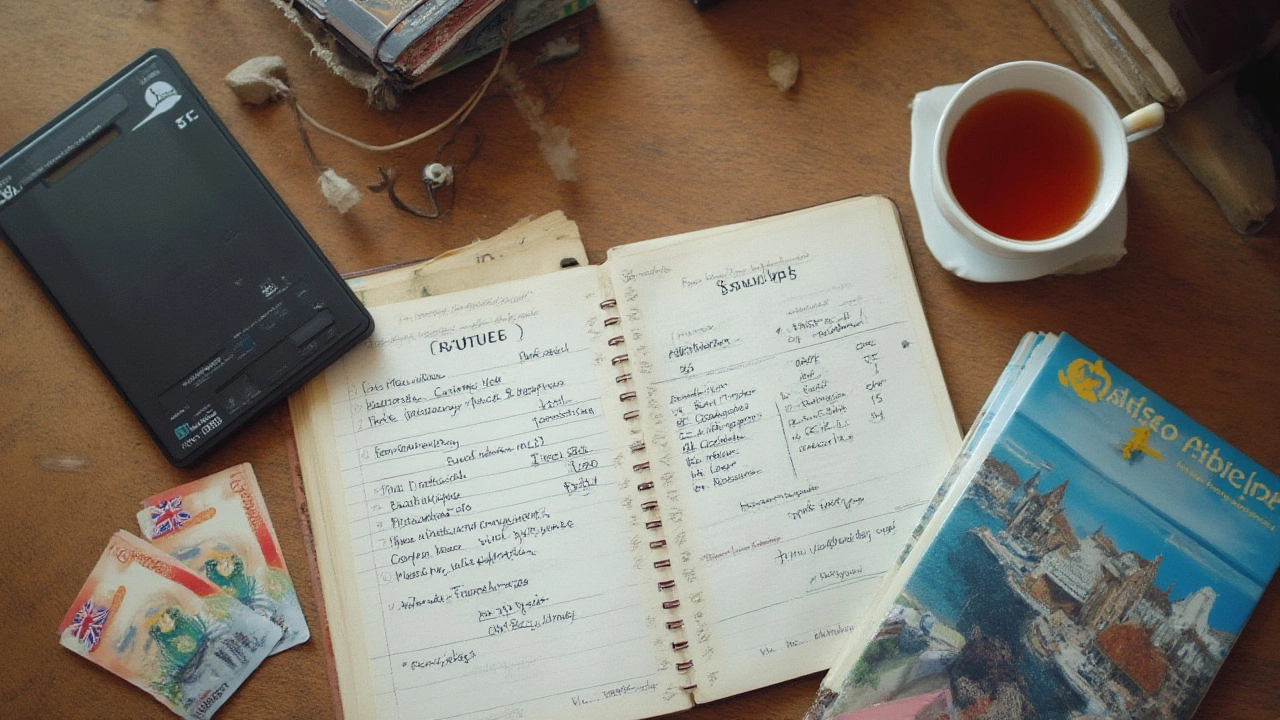Picture this: you’re lying by a pool that looks like it’s straight off a postcard, drink in hand, and you aren’t reaching for your wallet every two minutes. No bill arrives at the end of dinner. Your only job? To decide between the sushi bar and the taco cart. Sounds dreamy, right? But is the all-inclusive thing really all it’s cracked up to be—or is it a money trap dressed up with a sun hat and buffet spread?
The Real Deal with All-Inclusive: What Are You Actually Paying For?
The idea of going all-inclusive has a definite pull, especially if you’re the kind of person who hates haggling or gets anxiety every time a menu doesn’t list prices. But let’s talk about what you’re actually buying when you book all-inclusive. Most resorts mean exactly what you think: one price covers your accommodation, meals, snacks, most drinks, and often a whole menu of activities. But read the fine print. In a study from Expedia released in spring 2024, over 40% of travelers admitted they were "surprised" by hidden charges even at all-inclusive properties. Things like motorized watersports, top-shelf booze, spa treatments, or dinner at the "fancy" on-site restaurant? Those are usually extra.
So how all-inclusive is all-inclusive? The spectrum is wide. Mega-resorts in the Caribbean and Mexico typically include three meals a day, local drinks, pools, basic water activities, and evening entertainment. European hotels often do "half-board" (breakfast and dinner) or "full-board" (all meals, but not snacks or drinks), so don’t expect endless margaritas in Mallorca unless you double-check. You’ll also see some resorts just throw in a few perks (like basic cocktails but not wine, or free towel rental but paid chairs). Pro tip: always check what's "all" and what’s not. Ask for a full list ahead of time (the best hotels will happily email you a PDF of inclusions and exclusions).
Some places really do go all out—think Club Med or certain Sandals Resorts, which bake in extras like windsurfing lessons, snorkeling trips, or daily excursions. But outside that, "all-inclusive" can be a branding exercise. The safest bet is to think of it as a package—not a promise for truly limitless spoiling. Keep that mindset and you won’t feel short-changed.
If you’re traveling as a family, there’s a bonus. You don’t have to calculate the cost of every snack or ice cream your kids want (and believe me, they’ll want ice cream every afternoon). It means less arguing about splitting bills with friends, less mental math, and no awkwardness about who pays for the next round. For big groups, especially, the simplicity is gold.

Crunching the Numbers: Is All-Inclusive Cheaper or Just Easier?
Is it actually a money saver, though? That’s where it gets interesting. According to the 2024 Travel Price Index from Kayak, travelers who picked all-inclusive packages for seven-night stays in Mexico or the Dominican Republic spent, on average, 22% less than those booking hotels and dining separately—if, and only if, they took advantage of everything offered (three meals daily, plenty of drinks, and at least half the activities).
But it’s not always a steal. Singles, couples who eat lightly or prefer exploring local restaurants, and travelers who don’t drink much might see less value. If you’re adventurous and want to sample mom-and-pop taco joints or rent a car to explore, these extras can start to feel like missed opportunities that you’ve already paid for.
| Destination | Avg. nightly cost (all-inclusive) | Avg. nightly cost (hotel + meals/out) |
|---|---|---|
| Cancun | $280 | $340 |
| Punta Cana | $210 | $270 |
| Mallorca | $320 | $325 |
| Tenerife | $240 | $225 |
Notice something? The "deal" can flip, especially in some parts of Europe where local restaurant meals are reasonably priced and drinks aren’t gouged. But if you’re fueled by pina coladas and sun lounger lunches, you’ll usually come out ahead in the Caribbean and Mexico.
Don't ignore the non-obvious math. If you’re not a big eater or drinker, or you know you’ll want to leave the resort often, do the breakdown. Count how many meals the package covers, how much you truly drink, and compare the per-person, per-day cost to what you'd realistically spend outside. As I learned the hard way at a Tenerife resort, paying up front makes it tempting to stick around—even when your taste buds are craving something different off-property.
One hidden gem: some all-inclusives regularly run deep discounts, especially in shoulder seasons (think May and September) or on flash sale sites. Always price out the same dates both ways—packaged and pay-as-you-go. Travel advisors say a lot of travelers assume all-inclusive is always pricier, but new deals have flipped that logic in the last couple of years. For families or anyone who drinks a lot of premium alcohol, you can easily save several hundred dollars per person just by going bundled.
- Tip: Check if room service and minibar snacks are included—they add more value for money.
- Tip: Even in all-inclusives, staff tipping is often expected. Some higher-end resorts add service charges automatically, others don’t. Ask when you check in to avoid awkward moments later.
If you like excursions or want to see the area (say, touring cenotes in Riviera Maya or hiking in Madeira), see if the all-inclusive package lets you swap some meals for "picnic-to-go" or has a meal voucher system. These little details make a surprisingly big difference in how locked-in you feel.

The All-Inclusive Experience: Who Loves It, Who Doesn’t, and How to Get the Most Value
All-inclusive isn’t for everyone. It has massive fans and some very specific haters, often for the same reasons. People who never want to look at a receipt until check-out love the certainty: it’s hard to overspend, so you can relax. Also, if you’re a sociable sort, all-inclusives are great places to meet people—whether at trivia night, in the pool bar, or a random yoga class. They’re hands-down the easiest way to travel with a mixed group, with options for Lisa the picky eater, Mark the vegan, and your twelve-year-old niece who only eats chicken nuggets.
But there’s a flip side. Some travelers complain all-inclusives feel a bit like “travel with training wheels.” Food can get repetitive (yes, another buffet), local culture gets diluted (themed “Mexican Night” at a hotel in Cancun is not really the same as eating at a family-run taqueria downtown), and there’s definitely a vibe of never really leaving the resort bubble. Especially in 2024 and 2025, the "authentic travel" trend is big—people want more than just margarita refills and bingo nights. If you’re itching to explore, or you get restless with a fixed schedule, you might get FOMO watching the local street life from your pool lounger.
There’s a psychological side, too. Studies from Cornell University’s School of Hotel Administration show people at all-inclusives actually enjoy their vacations more when they feel they’re getting a deal. But, according to a 2023 survey by Skift, nearly a third of travelers at all-inclusives later wished they'd spent more time offsite. Balance is key.
If you want the best of both? Try "hybrid" resorts. These offer all-inclusive packages but don’t lock you down. For instance, some properties on Spain’s Costa del Sol have dine-around deals with local restaurants, and a few high-end Caribbean resorts let you swap meals for offsite experiences.
- Tip: Book a la carte restaurant reservations as soon as you arrive. Spots go fast, and you’ll need a break from the buffet.
- Tip: Ask if the resort runs free shuttles to nearby towns or markets—easy way to mix it up without extra expense.
- Tip: Check for "quiet pools" or adults-only zones if you want some downtime away from families.
- Tip: If booking during peak times (school holidays, Christmas, spring break), compare prices at both all-inclusives and regular hotels. Sometimes, the premium vanishes due to demand spikes.
Here’s something people don’t talk about enough: the vibe is only as good as the people around you. Some all-inclusives skew family-friendly and can feel like a theme park. Others are adults-only, with a party scene or a couples’ retreat mood. You’ll enjoy yourself a lot more if you book a place that matches your energy, not just your budget.
Want to squeeze every drop of value? Don’t be shy. Use the activities—kayak lessons, cooking classes, snorkeling trips—because you’ve already paid. Many travelers skip these, but they're often the best bits. Same goes for sunrise fitness sessions (if you’re up early) or evening shows. And if you’re not feeling it? There’s no all-inclusive police making you eat every meal on site. Grab a taxi into town when you need a taste of real life.
Bottom line—some travelers will never book anything else after their first go. Others? They’ll stick to Airbnb and dinner in the old town. But if you want a break from budgeting and decision fatigue, and you pick the right spot, there’s still a lot to love about not thinking about money until you hit the airport lounge.
Here’s a quick summary for when you’re booking:
- Check exactly what’s included and what’s not—especially drinks, activities, and special restaurants.
- Calculate a realistic cost for pay-as-you-go (local meal prices, drinks, taxis, activities), then compare with all-inclusive rates.
- Look for reviews about food variety and quality—these matter more than the number of pools or the spa menu.
- If you care about eco or local impact, look for all-inclusives with sustainability certifications or local hiring policies.
- Book a spot that matches your vibe: family, couples, party, or chill. The wrong crowd is more annoying than any buffet line.
Is it worth doing all-inclusive? For some, it’s the only way to travel—guaranteed relaxation, no awkward check-splitting, and everything sorted before you even board the plane. For others, it’s "holiday jail with unlimited bread rolls." The trick is picking the right place for how you actually travel—not just signing up for someone else’s vacation dream.
